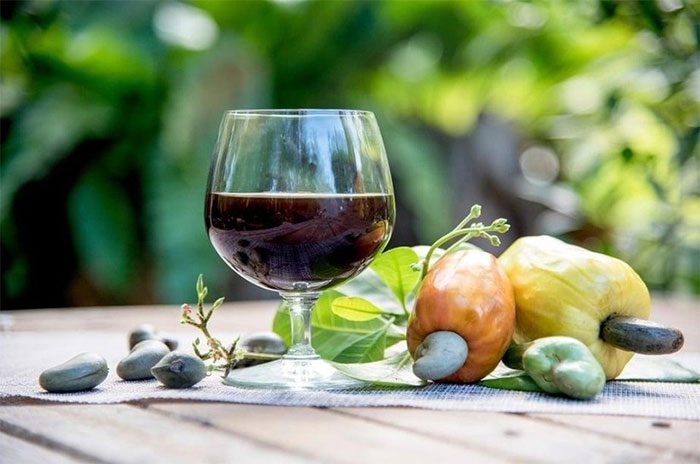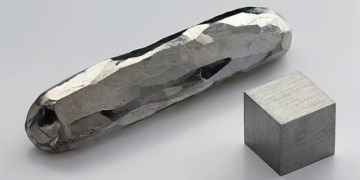Utilizing cashew fruit that is discarded after harvesting, scientists have fermented it into a nutrient-rich wine, enhancing the economic value for cashew farmers.
Vitamin C in Cashew Fruit is 5 Times Higher than Oranges
Dr. Nguyen Van Khoa from the Institute of Chemical Technology, Vietnam Academy of Science and Technology, stated that for every ton of raw cashew nuts harvested, approximately 8 to 10 tons of cashew fruit are discarded. This means that the amount of cashew fruit being wasted in Vietnam is estimated to be around 2 to 2.5 million tons per year.
Therefore, researching technology to process products like nutritious juice or cashew wine to utilize this abundant byproduct is an urgent need to increase the value for cashew farmers and create local specialties.

Cashew wine contains many vitamin-rich components beneficial for health.
Research shows that cashew juice contains high nutritional value, rich in vitamins B, C, and minerals. The vitamin C content is 219 mg per 100 ml of cashew juice, which is 5 times higher than that of oranges and 12 times higher than that of pineapples; magnesium content is 260 mg, higher than oranges and bananas; potassium content is 565 mg, which is double that of oranges and four times that of mangoes, and it contains many polyphenols with antioxidant properties, capable of resisting Helicobacter pylori which causes stomach ulcers and fighting cancer.
Although cashew juice has high nutritional value, it has a high tannin content (450 mg/100 ml) that causes an overly astringent taste and an unpleasant dry mouth feeling when consumed, leading to its disposal. This not only causes environmental pollution but also waste. Eliminating the astringency and utilizing cashew fruit is of great significance, and scientists are searching for solutions.
Dr. Nguyen Van Khoa noted that addressing the issue of separating tannins and reducing astringency in processed products from cashew fruit is a significant challenge. The key point in the technology for processing cashew wine is to thoroughly treat tannins because high tannin levels will result in an overly astringent taste, making it unpalatable. Secondly, selecting appropriate yeast strains and optimizing the fermentation process to create a product with suitable alcohol content and distinctive, delicious flavors is essential.
The resulting cashew wine is of high quality, with a unique aroma that differs significantly from wines made from other fruits, slightly strong when consumed, with a hint of spiciness. The nutrients and minerals in cashew wine are in higher concentrations compared to some standard fruit wines.
The polyphenol content is 2 to 3 times higher than that of white grape wine (29 – 29 mg GAE/100 ml), providing the wine with high antioxidant capacity, beneficial for health, with vitamin C levels exceeding those of fresh fruits (grapes, oranges, pineapples), high potassium content, and containing herbal flavors that create a pleasant taste when consumed.
Building a Specialty Wine Brand
The success of the research project led by Dr. Khoa helps to utilize the abundant byproducts of cashew fruit, increasing value for cashew farmers and creating local specialties.
At the same time, the research team has proposed a modern technology process for producing high-quality specialty cashew wine with a controlled tannin content.
According to previous studies, to separate tannin content, substances like gelatin, casein, egg whites, rice starch, and cassava starch are often used to precipitate protein-tannin complexes out of the solution. This traditional method has the disadvantage of being conducted at high temperatures of 60 to 80 degrees Celsius, which destroys the vitamin B and C content in cashew juice.
Moreover, tannins are useful polyphenols that are completely removed from the juice, reducing the beneficial polyphenol content and the antioxidant capacity of the initial cashew juice. The technology developed by the team has outstanding advantages, preserving the vitamin content found in cashew fruit.
Cashew fruit contains many nutritious components beneficial for health, but there are differences at various ripening stages (from green fruit to soft ripe fruit). Among them, the ripe yellow fruit (CV) has a tannin content of 250 mg/100 ml, vitamin C content (211 mg/100 ml), sugar (9%), minerals, polyphenols, and high antioxidant capacity, making it suitable for selection as a production material.
The project has initially successfully researched the process of making cashew wine from freshly harvested cashew fruit. The product has a distinctive aroma of cashew, is rich in nutrients, has high antioxidant capacity, and is good for health. The estimated production cost is highly competitive compared to other fruit wines on the market.
The research team recommends that the Ministry of Science and Technology continue to invest in implementing experimental production projects to bring the product to market, helping diversify offerings and create local specialties while increasing income for cashew farmers.



















































